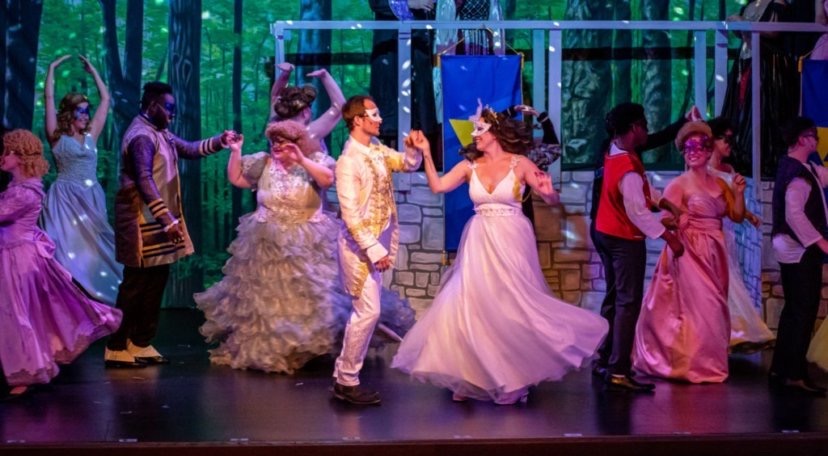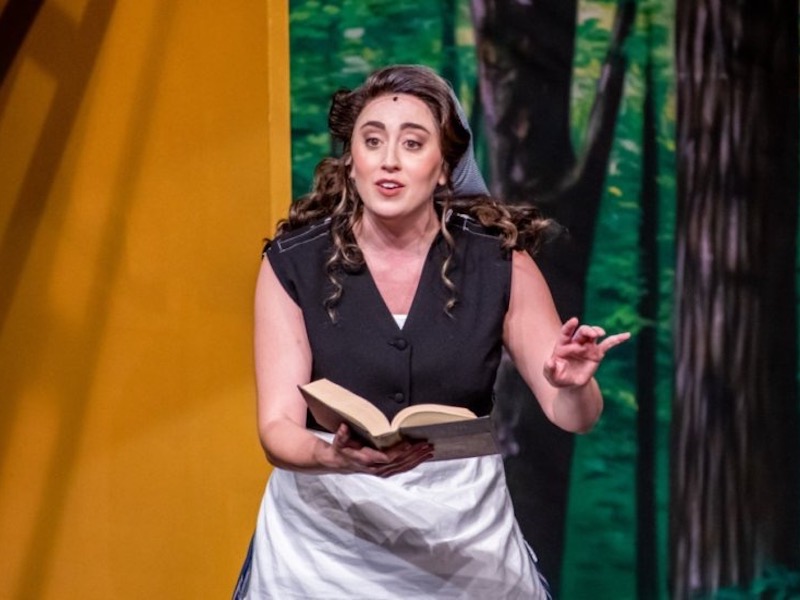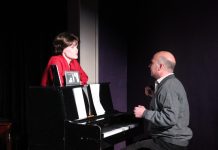How do you update a classic?
We live in an age when stories, movies, and shows from our childhoods are being constantly revived and rebooted, to decidedly mixed reviews. Do we value these remakes for their nostalgia value, or for the new perspectives they bring to the material?
Rodgers and Hammerstein’s Cinderella has been a perennial favorite since the live television version first aired on CBS in 1957, starring 21-year-old Broadway sensation Julie Andrews. The show, the only one Rodgers and Hammerstein wrote directly for television, was broadcast to a record-smashing audience of 107 million (out of an entire U.S. population at the time of 172 million). Since it was live, the performance was thought to be lost. But in 2002 a filmed dress rehearsal turned up; it can now be seen on YouTube (Rodgers & Hammerstein’s Cinderella (1957) – Julie Andrews). Although Andrews won an Emmy for her performance, the book of the show was considered lackluster, so it was rewritten and remade only eight years later, starring Leslie Ann Warren (with the added star power of Celeste Holm and Ginger Rogers), in the version that may be most familiar to the Boomers among us. It reappeared next in 1997, with the pop star Brandy Norwood in the title role, and a star-studded, diverse cast including Whitney Huston, Bernadette Peters, and Whoopi Goldberg.
Finally, in 2013, 56 years after it was written by perhaps the most famous Broadway writing team ever, Rodgers and Hammerstein’s Cinderella finally made it to Broadway. And this is the version you’ll see at Silhouette Stages.
But a show about a girl who sits around in rags dreaming and waiting for her Prince to come doesn’t fly in the 21st century. So how to update it for the age of female empowerment and income inequality?
First, with a dollop of politics. The social justice message grafted onto this fluffy tale is a little ham-handed, but it does what it needs to do. This Cinderella sets up class conflict with an evil Regent, Sebastian (played to the hilt by Christopher Kabara like Harvey Korman lampooning Lucius Malfoy), stealing land from the poor in the Prince’s name, and a red-shirted “firebrand” with the Les Mis-esque name of Jean-Michel (played by Johnny Dunkerly with amusing meekness for a revolutionary). He sends Cinderella to the palace with a mission — tell the Prince that the workers are being exploited and he must hear the people sing — um, listen to them!

This is, of course, an example of another thing a modern update requires: girl power. This Cinderella is not just a poor maid who sits dejected among the ashes wishing for a man to solve her problems. She is smart and resourceful, she reads, she cares for others, and she wants to do what’s right. It is up to her to help the Prince become the right kind of ruler. And here we have the flip side of the empowerment coin: while all the women in the show are strong, the heroes are full of self-doubt. Prince Topher (played by Zac Brightbill, in charming voice and looks a near dead-ringer for Neil Patrick Harris) has his own “I want” song (newly added from the Rodgers and Hammerstein back catalog) called “Me, Who Am I?” While easily besting evil sorceresses and slaying dragons, he is having an identity crisis, wondering if he will be a good enough king. He is sensitive, not suave. Jean-Michel also gets his own new (recycled R&H) song, “Now Is the Time,” which is humorously drowned out by “The Prince Is Giving a Ball” until the would-be revolutionary picks up his soapbox and leaves, dejected. He, too, is a hero with self-esteem problems, until Gabrielle (Hannah Elliott), a Stepsister with a surprising social conscience, reveals her love and plants a smooch on him. Then they are ready to take on the powers that be! The addition of this pair of comic lovers is a charming touch.
The final thing a modern update can’t do without is humor. This one has wisecracks to spare. There is even a moment at the ball where the guests play a game they call Ridicule, throwing sassy shade at each other for the Prince to judge. One of the best comic touches is the revamping of Charlotte, the other stepsister (played by Marela Kay Minosa with an almost uncanny resemblance to Ann Harada, who originated the role on Broadway). She leads the chorus in the always funny “Stepsister’s Lament,” and her hopeless attempts to snare the prince and her supply of well-landed laugh lines add spice to the show.
Many of the characters in this version are deeper than mere fairytale stereotypes, particularly the Stepfamily. The stepmother, Madame (an imperious Lauren Tobiason), is plotting and having an affair with the Regent, but shows moments of affection for Cinderella, and asks her forgiveness in the end. The Stepsisters spend less time fighting than harmonizing.
So, with its touches of social awareness, feminism, humor, and character development, this revamp works.
But what has always attracted people to R&H’s Cinderella most is the music. If the voices aren’t there, all the one-liners in the world won’t help. And this production has voices to spare.
Marie, the Fairy Godmother (Amanda Jones) and Lord Pinkleton (Otega Okurume) have top-notch operatic voices that carry their big numbers up to the rafters.

And Bailey Wolf is, quite frankly, the perfect Cinderella. She has the pipes, the vocal variety, the acting acumen, the softness, the sass, and the sheer stamina required to carry the whole show. Whether showing spunk or sweetness in her solos, soaring above the chorus or in a lovely duet with the Prince, she is sublime.
Music Director Paige Rammelkamp handles well the challenge of merging live singers with backing tracks and producing lovely harmonies (although the lyrics in the chorus could be clearer at times). The new score keeps almost all the original music and adds four new songs from the R&H catalog — an impressive feat.
The set, designed by Sammy Jungworth, has a lovely, wooded backcloth and a round disk onto which are alternately projected the sun, the moon, and the all-important clock at the castle (Projection Designers Richard and Amy Atha-Nicolls). The castle itself unfortunately seems a little rickety, and even lost a railing early on, which the actors gamely incorporated into their battle scene. The use of puppets and the pumpkin carriage are truly charming.
The choreographer Rikki Lacewell manages to convey the sense of a ballroom full of waltzers in the limited space available and fills the long chase sequences with amusing dance steps that got the idea across.

Given that the update required not just one but three magic transformation dresses, kudos to Costumer Deana Cruz-Conner. The other costumes also fit the purpose (although the ball dresses range wildly from 15th-century Renaissance to ’80s prom dresses). Cinderella and her Prince look lovely in paired white at the ball and later in a gold dress and blue coat that match the country’s banner (although it is hard to tell if the national emblem of a triangle of triangles is meant to reference or just resembles the Triforce from Legend of Zelda).
Hats off (as it were) to Wig Designer Tommy Malek for a range of looks from Madame’s red Winifred Sanderson updo to Sebastian’s sinister silver pageboy and more.
Sound Designers Alex Porter and Ethan Hogarty highlight the principals’ beautiful voices well. Unfortunately, the chorus offstage at the beginning was hard to distinguish, and there were some feedback and crackling issues that hopefully will be ironed out soon.
Veteran director TJ Lukacsina’s casting choices were impeccable, and he handled all the moving parts capably, eliciting humor, tenderness, and action as needed while keeping the pace taut. As he said in his Director’s Note, in all the versions of Cinderella, “The same basic plot is found throughout with each culture’s values added for the benefit of the next generation reading them.” And that is what we have here — a classic worthy of its update.
Come for the new, stay for the tried and true.
You’re sure to have “A Lovely Night.”
Running Time: Two hours 45 minutes, including intermission.
Rodgers and Hammerstein’s Cinderella plays through June 19, 2022 (Fridays/Saturdays at 8:00 pm, Sundays at 3:00 pm), presented by Silhouette Stages performing at Slayton House Theater in Wilde Lake Village Center, 10400 Cross Fox Lane, Columbia, MD. Purchase tickets ($15–$22) online.
COVID Safety: The venue requires proof of vaccination and ID for entry and masks to be worn at all times in the theater.
CAST
Ella: Bailey Wolf
Prince Topher: Zac Brightbill
Madame: Lauren Tobiason
Sebastian: Christopher Kabara
Marie: Amanda Jones
Gabrielle: Hannah Elliott
Charlotte: Marela Kay Minosa
Jean-Michel: Johnny Dunkerly
Lord Pinkleton: Otega Okurume
Ensemble: Matt Deitrich, Rene Kieth Flores, Sally Ann Flores, Megan Henderson, Bethany Jani, Benjamin Kintisch, Emily Letchworth, Michelle Moses-Eisenstein, Pamela Northrup, Sarah Robinson, Deacon Sweeting, Maggie Walker, Kaitlyn Wilson
PRODUCTION TEAM
Director: TJ Lukacsina
Stage Manager: Laura Fisher
Producer: Ande Kolp
Choreography: Rikki Lacewell
Music Director: Paige Rammelkamp
Intimacy Choreographer: Lauren Lowell
Costume Design: Deana Cruz-Conner
Makeup Design: Shemika Renée
Lighting Design: Donald Chiarella
Set Design: Sammy Jungwirth
Props/Scenic Design: Jessie Krupkin
Wig Design: Tommy Malek
Photography: Ana Johns
Show Graphic: Justin Johnson




